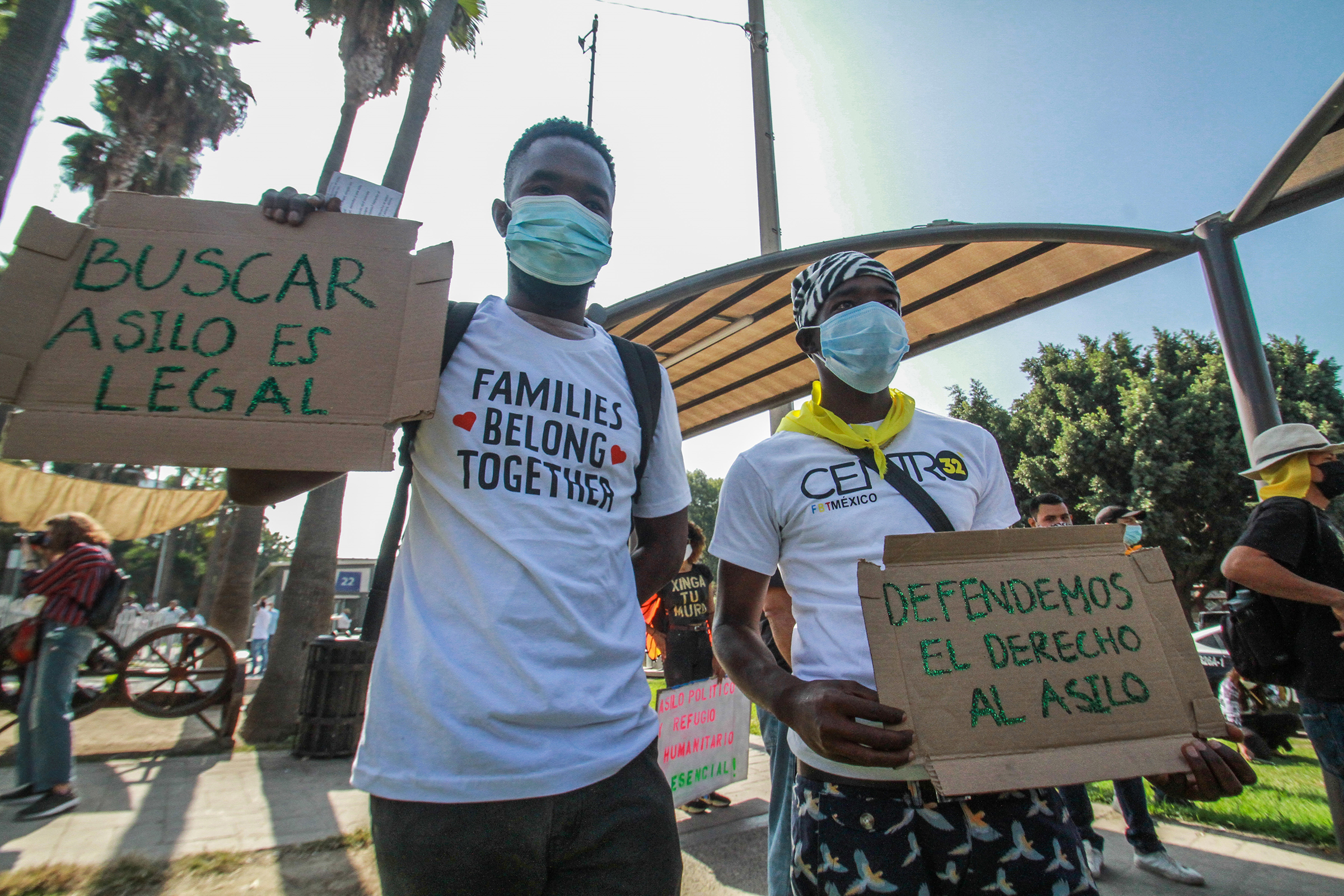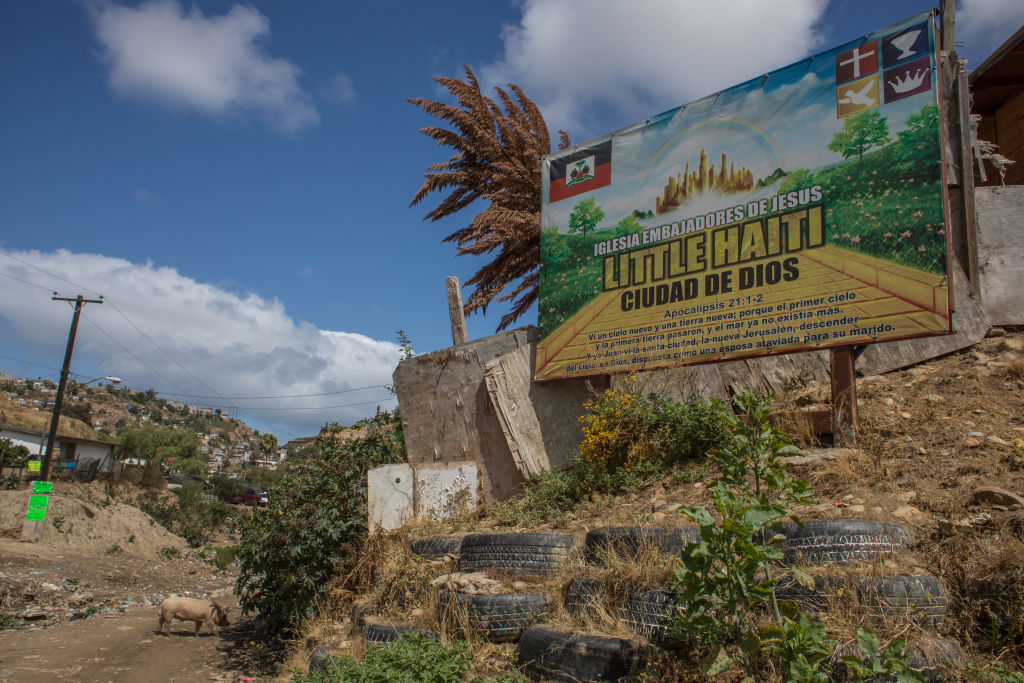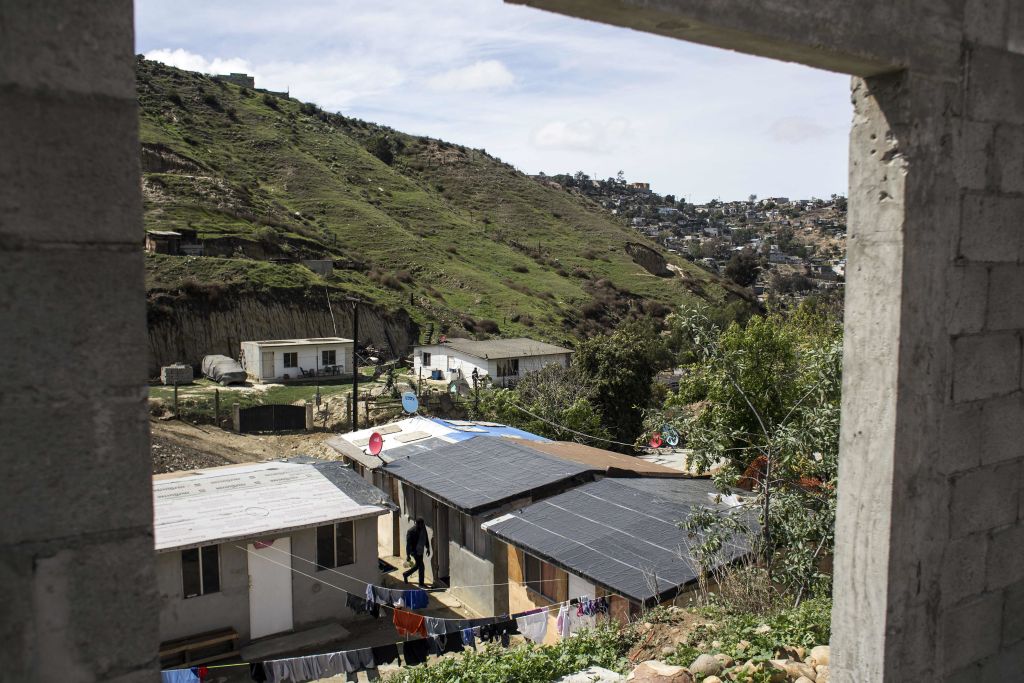
Sainte Helene’s son has been missing for about a year and a half. She avoids eye contact as she recounts the story, cradling her arms with her back hunched forward. A Haitian community leader named John helps translate from Haitian Creole to Spanish while we sit in the home she’s made for herself in Little Haiti, a tiny village in the remote hills of Tijuana, Mexico.
Sainte Helene says she fled Haiti in 2007 because of the instability and violence she encountered in her home country. She and her son originally found themselves in Venezuela, where she gave birth to a second son. After the country unraveled into political and economic instability, the family of three decided to travel north with a group of other migrants in late 2019, to Tijuana, where Sainte Helene knew other Haitians had fled. By the time they arrived in Panama, Sainte Helene realized the family was traveling too slowly to keep up with the group because she was carrying a young child. She allowed her eldest son, 14 years old at the time in December of 2019, to travel ahead of her with a group of others. She says she lost sight of him after a few hours while they climbed over a steep Panamanian mountain. Sainte Helene and her youngest child arrived in Tijuana in August of 2020. To her terror, she has not been able to locate or make contact with her eldest son.
“In my dreams he’s back with me,” Sainte Helene says. This day of our interview, April 25, also happens to be her birthday. Sainte Helene is now 43. She agreed to an interview with TIME on the condition that her last name be withheld for fear of her safety in Tijuana.
“I feel terrible all of the time, I’m always thinking about my son,” Sainte Helene says. “I don’t know if he died along the way, or if he made it to Tijuana, or maybe he even made it to the U.S.”
After about 15 minutes, Sainte Helene tired of sharing her story and got up from her seat to continue cooking dinner for the dozen or so other Haitian migrants who live here in Little Haiti. It’s a fenced off community of concrete homes in Tijuana just a few yards from a church that is sheltering hundreds of mostly Central American migrants arriving to the border. Though the population in Little Haiti has started to decline in recent months as migrants have spread to other parts of Tijuana and the U.S.-Mexico border the Haitian community in Tijuana has grown in recent years as Haitians have increasingly settled in the U.S. and South America after more than a decade of political instability and natural disasters. An estimated 5,000 to 10,000 Haitians have found themselves in Tijuana at some point since around 2015, according to the Haitian Bridge Alliance (HBA), a Southern California nonprofit that advocates for Haitian migrants in the U.S. and Mexico.
The community in Tijuana has come together in part because Black migrants in Mexico, Central America and South America have experienced frequent and pervasive racism. Here, there is some safety in numbers. Two signs greet you on the road into Little Haiti: one is a banner to let you know where you are—”Little Haiti” it reads in English, followed by “City of God,” in Spanish. The second sign is written in Spanish: “If you don’t live here, you cannot come in.”

While Haitian migrants have found themselves in many countries—such as the U.S., Canada, Brazil and the Dominican Republic—those who have found themselves at the U.S.-Mexico border are in a distressing state of limbo because of current U.S. immigration policies. Had they been in the U.S. in May, they would have been eligible to apply for Temporary Protected Status that would allow them to live and work in the country for 18 months. But living in Mexico, if they’re caught trying to illegally enter the U.S. or make a claim for asylum, they risk being expelled back to Haiti under Title 42, a Trump-era health measure that began in March 2020 and has remained in place under the Biden Administration. (Most people who are expelled are Central Americans who try to enter through Mexico, and are sent back to Mexico.) By HBA’s estimates, the Biden Administration has in a few months expelled more Haitians back to Haiti than during the entirety Trump Administration. According to research by HBA, which analyzed deportation flights to Haiti in partnership with the Quixote Center and the UndocuBlack Network, over 1,200 people had been expelled to Haiti between Feb. 1 and March 25 of 2021.
“U.S. policy has kept Haitian people from accessing the asylum process,” says Guerline Jozef, director of HBA. “From metering, to Title 42…the lives of these people were put in limbo due to U.S. policy and the lives of these people continue in limbo today as we speak.”
The U.S. Department of Homeland Security (DHS) did not immediately return TIME’s request for comment.
Decades of instability
In the last decade, Haiti has suffered through natural disaster, political turmoil, economic decline, rising gang violence and outbreaks of disease ranging from cholera to COVID-19. Earlier this month, the already reeling country was shaken when Haitian President Jovenel Moïse was assassinated and the country’s leaders engaged in a contentious power struggle, culminating in Moïse-appointed Ariel Henry taking the reigns on Prime Minister to form a new government.
Read more: Why Is a Florida-Based Pastor Under Arrest for the Assassination of Haiti’s President?
Haiti has become a predominately migrant-sending country, according to the Migration Policy Institute (MPI), a nonpartisan research institution, meaning more people emigrate from Haiti than immigrate to it. In 2010 a 7.0 magnitude earthquake killed hundreds of thousands of people—the Haitian government estimates as many as 300,000 were killed, though some estimates are smaller—setting in motion a mass migration to other parts of Latin America and the U.S. In preparation for the World Cup in 2014, thousands of Haitians were welcomed in Brazil to work, but found themselves unemployed and struggling when the World Cup was over. Throughout Latin America, Haitians and other Black migrants have faced nativism, racism and discrimination, blamed for everything from violence to natural disaster, according to MPI. Many have since journeyed north, to the U.S.-Mexico border, hoping to find a home in the U.S. Tijuana became a major port of entry for Haitian migrants around 2015, according to Jozef, who is also a Haitian immigrant herself, living in California.
At first, many were able to find humanitarian relief in the U.S., Jozef says, but in August of 2016 that humanitarian relief became harder to attain, and then came the Trump Administration’s immigration policies, such as “metering,” the Migrant Protection Protocols and Title 42, that created barriers to entry, forcing thousands to remain in Tijuana in a state of uncertainty.
Cadilis, 65, has lived in Little Haiti for a little over a year. He left his home country seven years ago, he says, because even when he did find work, he would immediately be robbed by gangs. Now, because he is a single adult in Tijuana, it may be even more challenging to enter the U.S. as the Biden Administration prioritizes families for relief from Title 42. “It’s hard isn’t it?” he says, as John interprets. “It’s really complicated to enter since I don’t have children, I don’t have family, I’m alone. The politics right now makes it complicated…Right now, it’s not possible. But it’s not that I don’t want to [move to the U.S.], it’s that I can’t.”
For its part, the U.S. has been trying to discourage Haitians from entering as well. DHS Secretary Alejandro Mayorkas issued a statement, urging both Haitians and Cubans not to journey to the U.S. for refuge via boat. “The time is never right to attempt migration by sea,” Mayorkas said on July 13. “Allow me to be clear: if you take to the sea, you will not come to the United States.”
‘I couldn’t take it anymore, so I came up to Mexico.’
Deeper into Tijuana, nearly 5 miles from Little Haiti, another group of about 30 Haitian migrants have been living together in a small home along with two small children. Several people from the home gather in a circle in the front patio, seated in plastic chairs, to listen to Jozef speak in Haitian Creole about their options, their likelihood of being able to make a claim for asylum in the U.S., and warnings of misinformation that spreads among migrant communities. Jozef invites anyone interested to sit down with her for a one-on-one conversation. One at a time they go inside, while a few others take turns pulling up a seat next to me to share their story. After years in Mexico, many of them have picked up Spanish, and we communicate without a translator as best as we can.
Read more: The Best Way for the World to Help Haiti in This Moment of Crisis
Amgello, 30, says he left Haiti because of the violence and lack of stable income. He traveled to Chile first. “In Chile I found it to be really racist,” Amgello says. “It was hard to find a job, and the people made it hard to live there. They would call Haitians ugly names. I couldn’t take it anymore, so I came up to Mexico.” His ultimate goal is to get his mother and young siblings out of Haiti, whether that means having them join him in Tijuana, or finding a way for them to migrate to the U.S. What he’d love, he says, is if his little sister in Haiti can get an education in the U.S.
“Most refugees and asylum seekers just by nature are vulnerable when they are in places that they’re unfamiliar with. But I think for Black immigrants it’s xenophobia, as well as very, very real anti-Blackness and prejudices they face” says Haddy Gassama, policy and advocacy director at the UndocuBlack Network, a U.S.-based organization that advocates on behalf of Black immigrants. “It’s not just that this country [Mexico] isn’t convenient, it’s literally that people’s lives are at risk every day that they’re along the southern border.”
Fretzner, 32, has been in Mexico for four years, after first migrating to Brazil from Haiti. He tells me his wife and child are still in Haiti, and he has worked out the paperwork to get them to Tijuana, now it’s just down to saving the money to afford to bring them. “And then after that we’ll figure out a plan for the U.S.,” he says. “What’s important first is that they’re with me and out of Haiti.”
Fretzner and Amgello say they have found it easier in Mexico than other parts of Latin America. They’ve been able to find work—though that work is paid poorly and under the table because they’ve struggled to obtain work visas—to send back home to their loved ones in Haiti. They’ve also been able to find a stable home, which can be a challenge for Black migrants who struggle to find a landlord willing to rent to them. “I’m still grateful for Mexico,” Fretzner says. “I came here without family, but I’ve gained a family and found love.” Though he’d ultimately want to rejoin family in the U.S., “I live for my beloved Mexico too,” he adds with a laugh. They say they don’t go out after dark, however, because they know how dangerous it can be for a Black man to wonder the streets of Tijuana.
An uncertain future

While Sainte Helene boiled chicken in Little Haiti, Remy, 52, who left Haiti three years ago and has lived in Tijuana for two years, gave his pal a shave outside the door. Remy has family in the U.S. waiting for him, he says, but sees no pathway to enter the U.S. “If I got the chance, I’d absolutely go [to the U.S.], because Mexico is still really hard to live in,” he says in Haitian Creole (John translates to Spanish), while his friend stares at me annoyed that I’m distracting from his shave. Remy left Haiti because of the instability, and because he was scared to walk the streets, even for work, he says, “you can go out and sell something, earn a little bit of money, and then you get jumped.” In Mexico, although he doesn’t have papers, he can work under the table to get himself by. Remy’s wife and son remain in Haiti, but he hasn’t been able to save enough money to bring them to Mexico. The community here in Little Haiti often depend on goods provided by HBA or other aid organizations.
While Remy and I talk, a father and his young son read through a children’s book and an Alice in Wonderland coloring book written in Haitian Creole. A woman hangs clothes to dry along the wires that stretch from home to home—she and her husband have been in Tijuana for four years. The community here used to be much larger, says Jozef, but many have given up on Tijuana and have moved to other parts of the U.S.-Mexico border.
Later, at the home for Haitians about five miles away from Little Haiti, I’m preparing to leave Tijuana as the sun begins to set. I’m pulled aside by another Haitian man. “Can you talk to me too?” he asks politely, and introduces himself as Sergio. “I’d like to share my story.”
We stood to the side, and he told me he and his wife live together in the house. They left Haiti in February 2018 because of the violence and lack of job opportunities, but left their children behind with relatives. They also have family in Miami and Brooklyn. Their hope was to save enough money to get their children out of Haiti, but work can be hard to come by in Tijuana he says. “There are so many Haitians here, but not enough work,” he says. “If after a few months we can’t figure out a way to earn, we’ll probably give up and go somewhere new.”
More Must-Reads from TIME
- Cybersecurity Experts Are Sounding the Alarm on DOGE
- Meet the 2025 Women of the Year
- The Harsh Truth About Disability Inclusion
- Why Do More Young Adults Have Cancer?
- Colman Domingo Leads With Radical Love
- How to Get Better at Doing Things Alone
- Michelle Zauner Stares Down the Darkness
Write to Jasmine Aguilera/Tijuana, Mexico at jasmine.aguilera@time.com